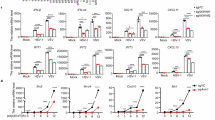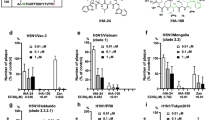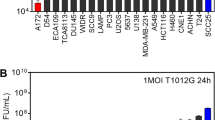Abstract
Depression is a serious public-health issue. Recent reports have suggested higher susceptibility to viral infections in depressive patients. However, how depression affects antiviral innate immune signaling remains unknown. Here, we revealed a reduction in expression of Abelson helper integration site 1 (AHI1) in the peripheral blood mononuclear cells (PBMCs) and macrophages from the patients with major depressive disorder (MDD), which leads to attenuated antiviral immune response. We found that depression-related arginine vasopressin (AVP) induces reduction of AHI1 in macrophages. Further studies demonstrated that AHI1 is a critical stabilizer of basal type-I-interferon (IFN-I) signaling. Mechanistically, AHI1 recruits OTUD1 to deubiquitinate and stabilize Tyk2, while AHI1 reduction downregulates Tyk2 and IFN-I signaling activity in macrophages from both MDD patients and depression model mice. Interestingly, we identified a clinical analgesic meptazinol that effectively stimulates AHI1 expression, thus enhancing IFN-I antiviral defense in depression model mice. Our study promotes the understanding of the signaling mechanisms of depression-mediated antiviral immune dysfunction, and reveals meptazinol as an enhancer of antiviral innate immunity in depressive patients.
Similar content being viewed by others
Log in or create a free account to read this content
Gain free access to this article, as well as selected content from this journal and more on nature.com
or
References
Alvarez Retuerto, A. I. et al. Association of common variants in the Joubert syndrome gene (AHI1) with autism. Hum. Mol. Genet. 17, 3887–3896 (2008).
Guze, S. B. & Robins, E. Suicide and primary affective disorders. Br. J. Psychiatry 117, 437–438 (1970).
Moussavi, S. et al. Depression, chronic diseases, and decrements in health: results from the World Health Surveys. Lancet 370, 851–858 (2007).
Leserman, J. HIV disease progression: depression, stress, and possible mechanisms. Biol. Psychiatry 54, 295–306 (2003).
Owora, A. H. Major depression disorder trajectories and HIV disease progression: results from a 6-year outpatient clinic cohort. Medicine 97, e0252 (2018).
Yanover, C. et al. What factors increase the risk of complications in SARS-CoV-2-infected patients? A cohort study in a nationwide Israeli Health Organization. JMIR Public Health Surveill. 6, e20872 (2020).
Liao, C. H., Chang, C. S., Muo, C. H. & Kao, C. H. High prevalence of herpes zoster in patients with depression. J. Clin. Psychiatry 76, e1099–e1104 (2015).
Irwin, M. R. et al. Major depressive disorder and immunity to varicella-zoster virus in the elderly. Brain Behav. Immun. 25, 759–766 (2011).
Canli, T. Reconceptualizing major depressive disorder as an infectious disease. Biol. Mood Anxiety Disord. 4, 10 (2014).
Jones-Brando, L. et al. Atypical immune response to Epstein-Barr virus in major depressive disorder. J. Affect. Disord. 264, 221–226 (2020).
Sun, L., Wu, J., Du, F., Chen, X. & Chen, Z. J. Cyclic GMP-AMP synthase is a cytosolic DNA sensor that activates the type I interferon pathway. Science 339, 786–791 (2013).
Rehwinkel, J. & Reis E Sousa, C. RIGorous detection: exposing virus through RNA sensing. Science 327, 284–286 (2010).
Kawai, T. & Akira, S. The role of pattern-recognition receptors in innate immunity: update on Toll-like receptors. Nat. Immunol. 11, 373–384 (2010).
Borden, E. C. et al. Interferons at age 50: past, current and future impact on biomedicine. Nat. Rev. Drug Discov. 6, 975–990 (2007).
Sadler, A. J. & Williams, B. R. Interferon-inducible antiviral effectors. Nat. Rev. Immunol. 8, 559–568 (2008).
Guo, T. et al. ADP-ribosyltransferase PARP11 modulates the interferon antiviral response by mono-ADP-ribosylating the ubiquitin E3 ligase β-TrCP. Nat. Microbiol. 4, 1872–1884 (2019).
Zuo, Y. et al. Regulation of the linear ubiquitination of STAT1 controls antiviral interferon signaling. Nat. Commun. 11, 1146 (2020).
Katlinski, K. V. et al. Inactivation of Interferon Receptor Promotes the Establishment of Immune Privileged Tumor Microenvironment. Cancer Cell 31, 194–207 (2017).
Huangfu, W. C. et al. Inflammatory signaling compromises cell responses to interferon alpha. Oncogene 31, 161–172 (2012).
Ortiz, A. et al. An Interferon-driven oxysterol-based defense against tumor-derived extracellular vesicles. Cancer Cell 35, 33–45.e36 (2019).
Xu, X. et al. Neuronal Abelson helper integration site-1 (Ahi1) deficiency in mice alters TrkB signaling with a depressive phenotype. Proc. Natl. Acad. Sci. USA 107, 19126–19131 (2010).
Porcelli, S. et al. Abelson helper integration site-1 gene variants on major depressive disorder and bipolar disorder. Psychiatry Investig. 11, 481–486 (2014).
Guo, D. et al. Tyrosine hydroxylase down-regulation after loss of Abelson helper integration site 1 (AHI1) promotes depression via the circadian clock pathway in mice. J. Biol. Chem. 293, 5090–5101 (2018).
Zhang, L. et al. Induction of OTUD1 by RNA viruses potently inhibits innate immune responses by promoting degradation of the MAVS/TRAF3/TRAF6 signalosome. PLoS Pathog. 14, e1007067 (2018).
Wang, B. et al. Ahi1 regulates the nuclear translocation of glucocorticoid receptor to modulate stress response. Transl. Psychiatry 11, 188 (2021).
Stark, G. R. & Darnell, J. E. Jr The JAK-STAT pathway at twenty. Immunity 36, 503–514 (2012).
Wilks, A. F. The JAK kinases: not just another kinase drug discovery target. Semin. Cell Dev. Biol. 19, 319–328 (2008).
Wilks, A. F. & Oates, A. C. The JAK/STAT pathway. Cancer Surv. 27, 139–163 (1996).
Luo, Q. et al. OTUD1 Activates Caspase-Independent and Caspase-Dependent Apoptosis by Promoting AIF Nuclear Translocation and MCL1 Degradation. Adv. Sci. 8, 2002874 (2021).
Yao, F. et al. SKP2- and OTUD1-regulated non-proteolytic ubiquitination of YAP promotes YAP nuclear localization and activity. Nat. Commun. 9, 2269 (2018).
Lu, D. et al. Mutations of deubiquitinase OTUD1 are associated with autoimmune disorders. J. Autoimmun. 94, 156–165 (2018).
van Londen, L. et al. Plasma levels of arginine vasopressin elevated in patients with major depression. Neuropsychopharmacology 17, 284–292 (1997).
Capuron, L. et al. Association of exaggerated HPA axis response to the initial injection of interferon-alpha with development of depression during interferon-alpha therapy. Am. J. Psychiatry 160, 1342–1345 (2003).
Pace, T. W., Hu, F. & Miller, A. H. Cytokine-effects on glucocorticoid receptor function: relevance to glucocorticoid resistance and the pathophysiology and treatment of major depression. Brain Behav. Immun. 21, 9–19 (2007).
Musselman, D. L. et al. Higher than normal plasma interleukin-6 concentrations in cancer patients with depression: preliminary findings. Am. J. Psychiatry 158, 1252–1257 (2001).
Capuron, L., Ravaud, A., Miller, A. H. & Dantzer, R. Baseline mood and psychosocial characteristics of patients developing depressive symptoms during interleukin-2 and/or interferon-alpha cancer therapy. Brain Behav. Immun. 18, 205–213 (2004).
Suzuki, H. et al. Altered populations of natural killer cells, cytotoxic T lymphocytes, and regulatory T cells in major depressive disorder: Association with sleep disturbance. Brain Behav. Immun. 66, 193–200 (2017).
Jahangard, L. & Behzad, M. Diminished functional properties of T regulatory cells in major depressive disorder: The influence of selective serotonin reuptake inhibitor. J. Neuroimmunol. 344, 577250 (2020).
Alvarez-Mon, M. A. et al. Abnormal distribution and function of circulating monocytes and enhanced bacterial translocation in major depressive disorder. Front. Psychiatry 10, 812 (2019).
Patas, K. et al. T cell phenotype and T cell receptor repertoire in patients with major depressive disorder. Front. Immunol. 9, 291 (2018).
Schleifer, S. J., Keller, S. E., Bond, R. N., Cohen, J. & Stein, M. Major depressive disorder and immunity. Role of age, sex, severity, and hospitalization. Arch. Gen. Psychiatry 46, 81–87 (1989).
Rivero, O. et al. Impact of the AHI1 gene on the vulnerability to schizophrenia: a case-control association study. PLoS ONE 5, e12254 (2010).
Ren, L. et al. Loss of Ahi1 impairs neurotransmitter release and causes depressive behaviors in mice. PLoS ONE 9, e93640 (2014).
Weng, L. et al. Loss of Ahi1 affects early development by impairing BM88/Cend1-mediated neuronal differentiation. J. Neurosci. 33, 8172–8184 (2013).
Flammer, J. R. et al. The type I interferon signaling pathway is a target for glucocorticoid inhibition. Mol. Cell. Biol. 30, 4564–4574 (2010).
Jin, W. Regulation of BDNF-TrkB signaling and potential therapeutic strategies for Parkinson’s Disease. J. Clin. Med. 9, 257 (2020).
Acknowledgements
We thank Dr. S.Y. Fuchs (University of Pennsylvania), Dr. J.W. Harper (Harvard Medical School), Dr. F. Shao (National Institute of Biological Sciences, Beijing), Dr. C. Wang (China Pharmaceutical University), Dr. G.Q. Chen (Shanghai Jiaotong University), Dr. L. Zhang (State Key Laboratory of Proteomics, Beijing), Dr. C. Dong and J. Dai (Soochow University) and C. Zheng (Fujian Medical University) for important reagents. We also thank Chenxi Irene Zheng in the Suzhou Industrial Park Xinghai Experimental Middle School for making the proposed model. This work was supported by grants from the National Key R&D Program of China (2017YFE0103700, 2018YFC1705500 and 2018YFC1705505), the National Natural Science Foundation of China (31770177, 31970846, 81120108011, 81771454, and 82071511), Jiangsu Provincial Distinguished Young Scholars (BK20130004), the Priority Academic Program Development of Jiangsu Higher Education Institutions (PAPD).
Author information
Authors and Affiliations
Contributions
H.-G.Z., B.W., Junjie W., N.X., Y.M., Q.W., T.G., Y.Yuan, Y.Z., X.C. and T.R. performed the experiments. B.W., Y.Yang, X.L., S.L., Jun W., M.S. and X.X. assisted with collection and analysis of healthy controls and MDD patients. B.W., Junjie W. and N.X. helped with the depression mouse model. H.R. assisted with the RNA-Seq analysis. H.Z., X.X. and H.-G.Z. designed experiments, analyzed data and wrote the manuscript. H.Z., X.X., C.D., Jun W., and M.S. discussed the manuscript. H.Z. and X.X. was responsible for research supervision, coordination, and strategy.
Corresponding authors
Ethics declarations
Competing interests
The authors declare no competing interests.
Rights and permissions
About this article
Cite this article
Zhang, HG., Wang, B., Yang, Y. et al. Depression compromises antiviral innate immunity via the AVP-AHI1-Tyk2 axis. Cell Res 32, 897–913 (2022). https://doi.org/10.1038/s41422-022-00689-9
Received:
Accepted:
Published:
Issue date:
DOI: https://doi.org/10.1038/s41422-022-00689-9
This article is cited by
-
Chronic stress in mice: how gut bacteria influence gene activity in key brain neurons
Translational Psychiatry (2025)
-
Immunopotentiating effects of herb-partitioned moxibustion on the spleens of cyclophosphamide-induced immunosuppressed rats
Chinese Medicine (2024)
-
Molecular signatures of premature aging in Major Depression and Substance Use Disorders
Scientific Data (2024)
-
Abelson Helper Integration Site 1 haplotypes and peripheral blood expression associates with lithium response and immunomodulation in bipolar patients
Psychopharmacology (2024)
-
GR/Ahi1 regulates WDR68-DYRK1A binding and mediates cognitive impairment in prenatally stressed offspring
Cellular and Molecular Life Sciences (2024)



